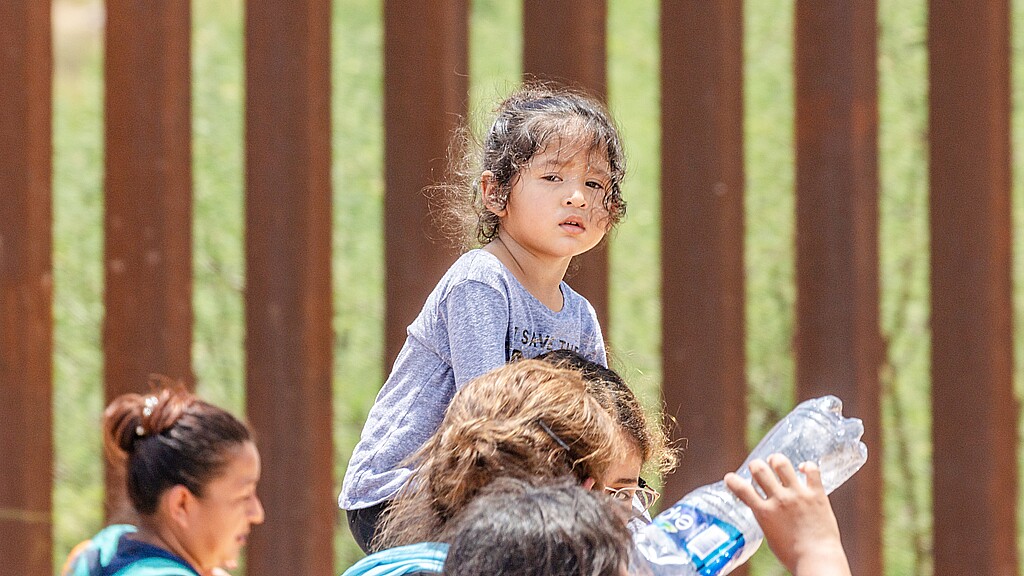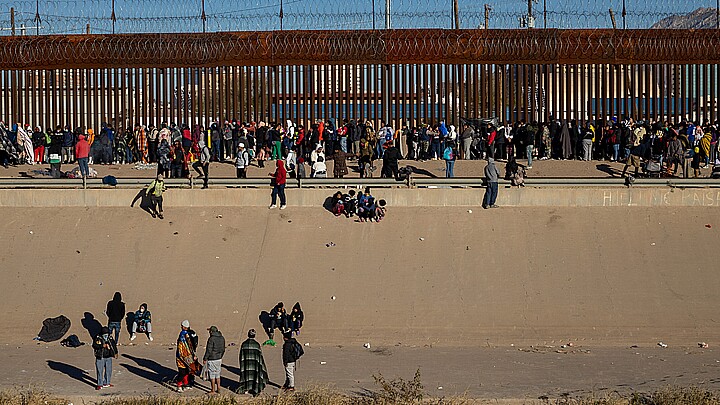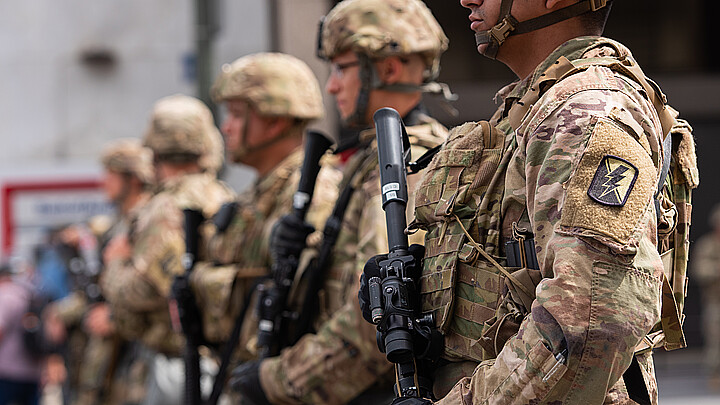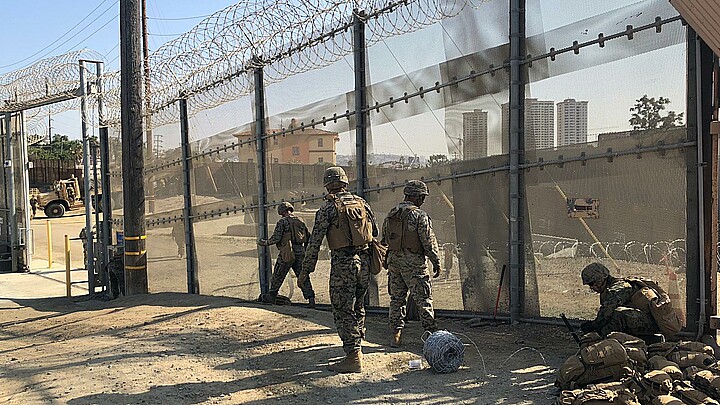Immigration
Humanitarian crisis heating up in Arizona desert that has become destination point for migrants, says report
Many of the migrants are hoping by traveling to a common international arrival point, they will find family members and relatives once they successfully cross the southwest U.S. border

December 11, 2023 8:56am
Updated: December 11, 2023 8:56am
A humanitarian crisis is heating up in a remote Arizona desert that has become an unofficial destination point for migrants from Latin America, the Middle East and Asia, according to a new investigative report published by CBS News.
Many of the migrants are hoping by traveling to a common international arrival point, they will find family members and relatives once they successfully cross the southwest U.S. border.
In the past week, significantly sized groups of migrants, many with children, have turned Organ Pipe Cactus National Monument, a section of the southwest border into an outdoor waiting room while waiting to be processed by U.S. Border Protection agents who are facing a harsh backlog.
CBS found that many of the migrant men waiting in the desert area are from Ecuador and other parts of Latin America whereas the families with children were from Mexico and Central America.
Some of the single male travelers were from African countries such as Guinea, Mauritania, Morocco and Senegal.
They also hailed from Asian countries such as Bangladesh, India, and Nepal as well as Middle Easter countries such as Pakistan and Syria.
The migrants have set the remote desert area up almost as an overnight camping ground with blankets and campfires set a night to keep warm as the Arizona desert begins to face cold winter temperatures.
Some Mexican families have reportedly visited the new waiting area selling food and drinks, which CBS described as “burritos, tamales and cups of coffee from the other side of the border wall.”
One 31-year-old mother from Mexico, Daniela Segura Salgado, told the national news network while shivering that she was there with her 1-year-old baby, two girls aged 3 and 9-old and an 11-year-old boy.
"We didn't sleep like we should," Segura Salgado said, as she raised the issue of dropping temperatures. "But sleep would win me over at times because I'm really tired from a lot of walking with my children. My son in my arms and my daughter up on my shoulders."
According to the National Park Service, the Organ Pipe Cactus National Monument desert area can reach temperatures as hot as 100 degrees Fahrenheit during the day and as low as the 30s at night.
Reports from the National Weather Service indicated the desert area reached lows of 40 degrees early Sunday morning and temperatures of 47 degrees during the small hours of Monday morning.
The scene in the Arizona desert resembles a similar problem that erupted last Christmas in El Paso, along the Tex-Mex border when there was a 40% migrant surge in the area.
El Paso and federal authorities declared a state of emergency as the migrants sleeping outside on the streets were facing freezing temperatures as cold as 21 degrees and faced a brewing winter storm.
The unfolding migrant encampment in the Arizona desert is just the latest chapter of potential humanitarian crises along the southern border which record numbers of migrants have been crossing in the past two years.
“For only the second time ever, Border Patrol apprehended more than 2 million migrants who entered the U.S. illegally in fiscal year 2023. Defying historical seasonal trends, illegal border crossings have spiked this month. Over the past several days, Border Patrol has processed near-record levels of migrants, making roughly 10,000 apprehensions every 24 hours, up from the 6,000 daily average in October,”
CBS reported, attributing the figures to internal government data obtained by CBS News.
Most of the migrants crossing the southwest border have not been screened for asylum and the U.S. is lacking an adequate number of asylum officers and holding facilities, according to CBP statistics.
“U.S. Border Patrol facilities, such as stations and central processing centers, provide short-term holding capacity for the processing and transfer of individuals encountered by agents. Maximum facility capacity along the Southwest border is approximately 21,000, which assumes a homogenous population and full operating status at all facilities. Actual capacity fluctuates constantly based on characteristics of in-custody population, to include demographics, gender, criminality, etc.,” the CBP reports.
The lack of resources is becoming a growing problem since those migrants not deported under expedited removal are usually released with notices to return to court at significantly later dates. In many instances, the immigration cases can take as long as several years to come to a resolution.
“More than 2 million cases are pending in U.S. immigration courts,” according to an online report published by the Government Accountability Office (GAO) on Oct. 19, 2023.
“This backlog has more than tripled since the start of fiscal year 2017. The effects of the backlog causes delays and poses challenges for noncitizens whose cases are being heard in immigration courts, as well as attorneys and immigration judges and court staff. Some noncitizens—including children and families—wait years to have their cases heard. The delays postpone decisions for vulnerable populations who may be eligible for protections, such as asylum. They also prolong the removal from the U.S. of those who do not have valid claims to remain.”
Since the migration crisis has increased, ADN has reported that there has been an influx of migrants crossing the Darien Gap, a 575,000 kilometer jungle that land connects South America to Central America from Colombia into Panama, prompting the latter country to close the natural land bridge.
In the first six months of the year, about 23,079 Venezuelans had crossed the Darién Gap, according to figures published by Migration Panama. By September, an estimated 350,000 migrants had crossed the jungle land bridge.
The crossings have endangered migrants and those who have survived its crossing have shared their stories have gone as far to say that the Darién Gap “smells like death.”
"You have to pass rivers and climb hills. You get weak, you get short of breath, and your blood pressure rises. You feel you don't want to go on any longer, but you only have two options: go on or stay there to die. Everyone fights for their lives to get to their destination. No one helps anyone there," commented Cristina, a name one Venezuelan migrant used at her request in a July 16, 2022 telephone interview with news site El Pitazo.
While Venezuelans have made up the majority of those migrating from South America, there has been a growing number of Ecuadoreans amid increasing violence and economic downturn.
According to the CBS report, some of the Ecuadorian men, along with Africans, told Border Patrol agents they spent weeks trekking across Latin America to find job opportunities in the United States, which, unlike flight from political persecution, does not make them eligible for asylum.
“Over the past few years, however, the U.S. asylum system has become a proxy process for migrants to stay and work in America, irrespective of whether they have valid claims or not. A mounting backlog of roughly three million pending cases has crippled the federal immigration court system's ability to adjudicate claims in a timely fashion,” CBS reported.
While some migrants interviewed at the Organ Pipe Cactus National Monument have told authorities they came to the U.S. for better economic opportunities, others have said their lives were at risk in their home country.
Some migrants braving the elements in the Arizona desert said they were escaping dangerous situations.
Segura Salgado, the migrant mother CBS interviewed from Mexico, told the network news station she came to the U.S. to escape violence in the Mexican state of Guerrero, a region riddled with drug trafficking and violence where one of her family relatives were killed.
"I am fighting as much as I can so my children can have something better. A warm bed where they can sleep without having to hear a gunshot," Segura Salgado said.
Congressional Republicans are currently taking steps to compel the Biden administration into reforming the asylum system and halt the migration flow at the border.
They have tried to bifurcate aid to Israel, Ukraine and Taiwan from other spending bills, demanding that aid to Ukraine includes new asylum restrictions.
While some have remained hopeful the GOP’s push could finally lead to some positive changes at the border, there is a long history of unsuccessful attempts to reform the immigration system ever since the administration of President George W. Bush.
Currently, migrants are utilizing a new mobile phone app that helps them schedule interview appointments at various southwest border points of entry.
As the migration problem has continued to rise, governors in states such as Florida and Texas have relocated some border crossers to cities such as Chicago, Los Angeles and New York, sparking a fury from Democratic mayors and governors from those jurisdictions.
On Aug. 14, ADN reported that a three-year old child died on one of the busses that were being used to transport migrants from Texas to New York.
According to CBP, many of the migrants currently camping out in the Organ Pipe National Monument desert were located to the border by smuggling organizations.
As a result, many of the agency’s officers are being located to Arizona desert national park to investigate transportation companies used by the smugglers, CBS reported.
On Sept. 15, 2023, Arizona State Rep. Ruben Gallegos released a statement in which he said he was actively pushing DHS Secretary Alejandro Mayorkas to get his state’s border under control.
“For months, Arizonans have borne the brunt of a national crisis and recent rapid street releases are only further straining our migrant-aid system,” wrote in the statement.
The Arizona state representative said while on a phone call with Mayorkas, he stressed that DHS needed to amplify resources and funding to border communities as well as better communication and coordination with local leaders.
“This is a national crisis which requires a national response, starting at the border. Border communities and nonprofits cannot do the job alone,” he wrote. “I’ll continue pushing the Administration and Congress to step up and do better to support Arizonans.”










